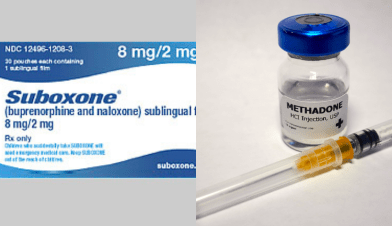
Opioid addiction is a pervasive and challenging condition affecting millions of individuals worldwide. Effective treatment is crucial to help those struggling with addiction regain control over their lives. Two commonly used medications in opioid addiction treatment are Suboxone and Methadone. Both have proven effective, but they function differently and are suitable for different types of patients. This article aims to provide a detailed comparison of Suboxone and Methadone, covering their mechanisms, effectiveness, side effects, and more to help patients and healthcare providers make informed decisions.
What are Suboxone and Methadone?
Suboxone is a combination medication containing buprenorphine and naloxone. Buprenorphine is a partial opioid agonist, which means it partially activates opioid receptors in the brain, reducing cravings and withdrawal symptoms without producing the intense high associated with full opioids. Naloxone is an opioid antagonist that blocks the effects of opioids and prevents misuse.
Methadone, on the other hand, is a full opioid agonist. It activates opioid receptors to a similar extent as other opioids, but it does so more slowly and steadily, which helps to reduce cravings and withdrawal symptoms without the euphoric high. Methadone has been used for opioid addiction treatment since the 1960s and is available in various forms, including oral solutions, tablets, and injectables.
Mechanisms of Action
Suboxone works by combining buprenorphine’s partial agonist effects with naloxone’s antagonistic properties. Buprenorphine binds to opioid receptors and partially activates them, which helps to mitigate withdrawal symptoms and reduce cravings. The presence of naloxone, which is inactive when Suboxone is taken as prescribed, deters misuse by causing withdrawal symptoms if the medication is injected.
Methadone, as a full opioid agonist, binds to and fully activates opioid receptors. This mechanism helps to alleviate withdrawal symptoms and reduce cravings but carries a higher risk of dependence and potential for misuse compared to Suboxone. Methadone’s longer half-life allows for once-daily dosing, which helps maintain stable blood levels and minimizes the risk of withdrawal between doses.
Usage in Treatment Phases
Suboxone is approved by the FDA for both the induction and maintenance phases of opioid dependence treatment. During the induction phase, it is used to ease withdrawal symptoms as the patient reduces or stops opioid use. In the maintenance phase, Suboxone helps to manage cravings and prevent relapse over the long term.
Methadone is primarily used in the maintenance phase of treatment but can also be used off-label during the induction phase. It is administered daily at a specialized opioid treatment program (OTP) clinic, where patients are closely monitored. Methadone’s effectiveness in reducing cravings and withdrawal symptoms makes it suitable for long-term maintenance therapy.
Administration Methods
Suboxone is typically administered as a sublingual film or tablet, which is placed under the tongue or between the gums and cheek to dissolve. This method ensures rapid absorption and onset of action.
Methadone is available in various forms, including oral solutions, tablets, and injectables. The most common form for addiction treatment is the oral solution, which is taken daily under supervision at an OTP clinic. Tablets and injectable forms are used less frequently and typically reserved for specific medical situations.
Effectiveness and Success Rates
Comparative studies have shown that both Suboxone and Methadone are effective in treating opioid dependence, but their success rates can vary based on individual patient factors. Suboxone is often preferred for patients with a lower level of physical dependence due to its partial agonist properties and lower potential for abuse. It has been shown to improve treatment retention and reduce illicit opioid use.
Methadone, with its full agonist effects, is more suitable for patients with a higher level of dependence or those who have not responded well to other treatments. It has been shown to significantly reduce opioid use and improve social functioning, though it requires more intensive monitoring and carries a higher risk of side effects and dependence.
Side Effects and Risks
Suboxone Side Effects:
- Common: Headache, nausea, vomiting, constipation, sweating, insomnia.
- Serious: Respiratory depression, liver damage, hormonal imbalances, severe withdrawal symptoms if abruptly discontinued.
Methadone Side Effects:
- Common: Constipation, sweating, weight gain, sexual dysfunction, drowsiness.
- Serious: Respiratory depression, cardiac arrhythmias, overdose, significant drug interactions.
Both medications carry risks of serious side effects, particularly when combined with other substances like alcohol or benzodiazepines. Methadone, due to its full agonist properties, has a higher potential for overdose and respiratory depression, especially when taken inappropriately. Suboxone, with its combination of buprenorphine and naloxone, is designed to minimize the risk of misuse but can still cause significant adverse effects if not used correctly.
Addiction and Dependency Potential
Methadone is classified as a Schedule II controlled substance due to its high potential for abuse and dependence. It requires strict regulation and supervision, often necessitating daily visits to an OTP clinic for dosing. Despite these measures, methadone has a well-documented risk of addiction, which can complicate its use in treating opioid dependence.
Suboxone, classified as a Schedule III controlled substance, has a lower potential for abuse compared to methadone. Its partial agonist properties and the presence of naloxone reduce the risk of dependence and misuse. However, it is not without risk, and patients can still develop a dependence on Suboxone, especially if used for extended periods or not as prescribed.
Pros and Cons
Pros of Suboxone:
- Lower potential for abuse and dependence.
- Can be prescribed and taken at home, reducing the need for daily clinic visits.
- Effective in reducing cravings and withdrawal symptoms.
Cons of Suboxone:
- May not be effective for patients with high levels of physical dependence.
- Risk of severe withdrawal symptoms if abruptly discontinued.
- Potential side effects, including liver damage and respiratory issues.
Pros of Methadone:
- Highly effective for patients with severe dependence.
- Long history of use and well-documented efficacy.
- Can be used in both induction and maintenance phases of treatment.
Cons of Methadone:
- Higher potential for abuse and dependence.
- Requires daily visits to an OTP clinic, which can be burdensome.
- Significant risk of serious side effects, including overdose and cardiac issues.
Patient Considerations and Choosing the Right Treatment
Choosing between Suboxone and Methadone depends on various factors, including the patient’s level of opioid dependence, lifestyle, and any co-occurring medical conditions. Patients with a lower level of physical dependence and a stable home environment may benefit more from Suboxone due to its lower abuse potential and flexibility in administration.
Patients with a higher level of dependence or those who have not responded well to other treatments may find Methadone to be more effective, despite its higher potential for abuse and the need for daily clinic visits. It is crucial for patients to discuss their options with healthcare providers to determine the best treatment plan based on their individual needs and circumstances.
Reach out to Carty Addiction Medicine if you are in need of Suboxone
In summary, both Suboxone and Methadone are valuable tools in the fight against opioid addiction. Each medication has its unique advantages and disadvantages, making them suitable for different types of patients. Suboxone offers a lower potential for abuse and greater flexibility in administration, while Methadone provides robust treatment for severe dependence but requires more intensive monitoring. Ultimately, the choice between these medications should be made in consultation with a healthcare provider, considering the patient’s specific needs and treatment goals. For more information and support on opioid addiction treatment, visit Carty Addiction Medicine.
You Might Also Enjoy...
Treatment of Opioid Use Disorder
Treatment of Opioid Use Disorders Often Produces Dramatic and Life-Changing Benefits Although there is a national epidemic of opioid misuse and overdoses, treatment is effective. The most effective treatment is…
Jun 3, 2019Does Marijuana Lower IQ?
Who was ever harmed by smoking a little weed? Right? Wrong. Good research shows that people who start smoking marijuana, or cannabis, regularly when they are in their teens and…
Jun 3, 2019Imprisoned pharmaceutical investor Martin Shkreli put in solitary confinement for illicit cell use
Pharmaceutical investor Martin Shkreli, already in prison for securities fraud, was transferred to solitary confinement in March for using a contraband cellphone to run his drug company Phoenixus AG from…
Jun 26, 2019


